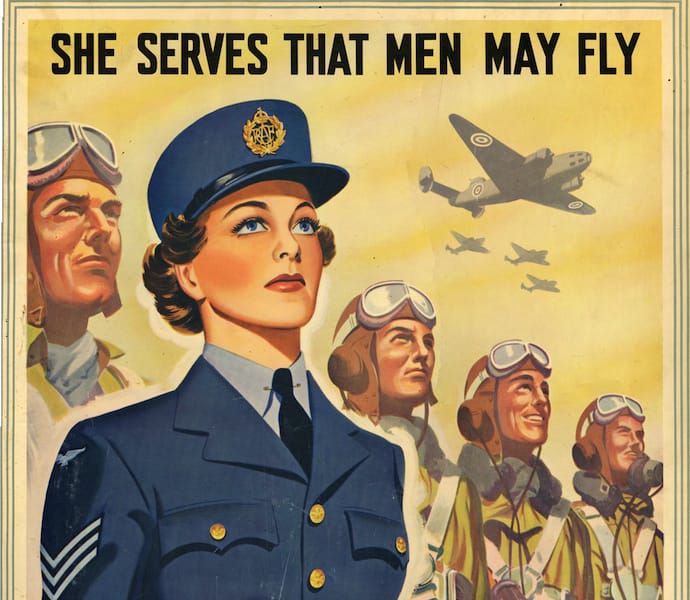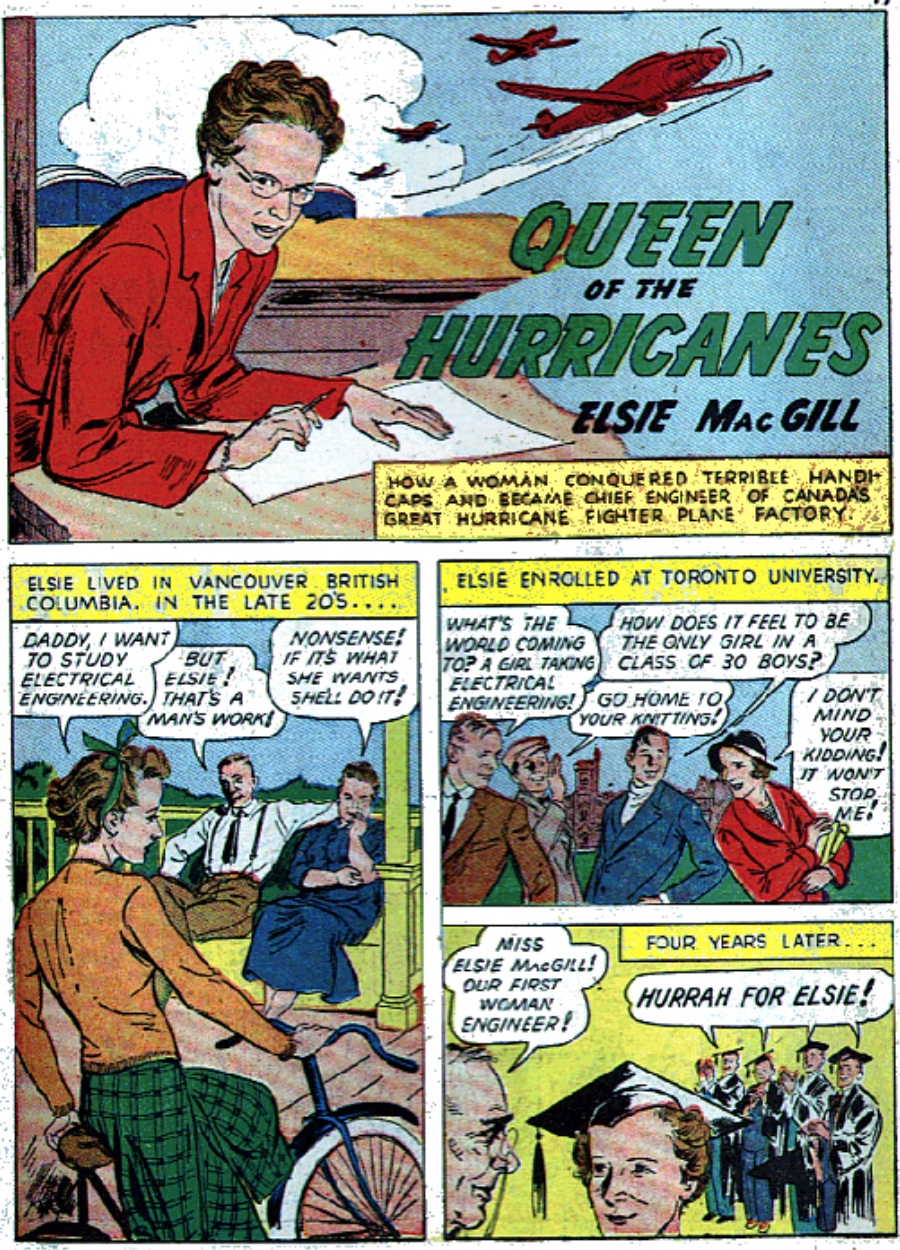Women in War

In 1939 there were no women in the RCAF. The RCAF Women's Division began in 1941 and employed over 17,000 women in non-combat roles. Twenty from Women's Division received the British Empire Medal, 12 officers received the Member of the British Empire, and one officer, Dr. Jean Davey, was awarded the Order of the British Empire. Twenty-eight Women's Division died during the war from various causes. Museum Canada 150 Project (BCATP)
Squadron Officer Kathleen Lorena Jeffs (Toronto), awarded MBE (Member of the British Empire), January 1, 1944 for work in the Directorate of Supply Administration, AFHQ, Ottawa.
Squadron Officer Jeffs, as Chief Messing Officer to the RCAF, has personally reorganized the messing services and established a messing branch of the Women's Division consisting of highly qualified dieticians. Under her direction a very high standard of Service messing has been achieved which has been an important contribution to the welfare and morale of aircrew training in Canada. This officer has displayed outstanding ability and energy in the performance of her duties.
Both WW1 and WW2 exapnded the roles of women. Women also continued in traditional roles, those roles were more highly valued.
- These videos describe the exapnding role for women in both wars, as well as expand on the tradional roles in war time.
 Women at War World War 1 (York University 6:44)
Women at War World War 1 (York University 6:44)
- In 1941-1942 the Women's Division was official added to the RCAF. It was mostly a measure to free up man for combat. However many women had very distinguished service records.
 RCAF Women's Division from Juno Beach Centre
RCAF Women's Division from Juno Beach Centre RCAF Women's Division in Britain (1:43)
RCAF Women's Division in Britain (1:43)
- Elsie MacGill, "Queen of the Hurricanes".
 Elsie MacGill, first women Aerospace Engineer, was also a comic book hero.
Elsie MacGill, first women Aerospace Engineer, was also a comic book hero. Queen of the Hurricanes (1:00)
Queen of the Hurricanes (1:00) Elsie MacGill, Queen of the Hurricanes (5:29)
Elsie MacGill, Queen of the Hurricanes (5:29) Roberta Bondar on Elsie MacGill
Roberta Bondar on Elsie MacGill Elsie MacGill Comic Book story from WW2
Elsie MacGill Comic Book story from WW2
- Special Military Roles of Women in Canada
 Canadian Women Codebreakers (11:43)
Canadian Women Codebreakers (11:43) Canadian Women in Air Transport Auxiliary (3:33)
Canadian Women in Air Transport Auxiliary (3:33)
- Women Pilots in Canada
Today woman pilots in Canada are too numerous to mention, but that has not always been the case. These are some of women who pioneered the change in women's roles in flying.
 Canadian Woman Pilots Through the Years
Canadian Woman Pilots Through the Years
Air War Casualties: Women in War (2)
Assignment:
- Review the videos and links above (sections 1-5)
- Review Joan Margaret Cole-Hamilton
- Review Maxine Gloeckner
- Answer the questions below
Women in War
Canadian Women had an active and very important role in World War II. Answer the following questions to discover how Women helped win the War.
Watch the video “World War II Women†and answer questions 1 and 2.
- When the War began (in 1939) women began to take on roles that men usually had. Give six examples of jobs women began to do.
- There were over 17,000 women who signed up for what would become the Women’s Division of the Royal Canadian Air Force (RCAFWD).
- List three important jobs they did that were important to the War effort.
- All the Women’s jobs in the RCAF were “non-combat†roles. What do you think the term “non-combat†means?
- Why do you think Women were only allowed to have non-combat roles? (Hint: Think of how women were viewed back in the 1930’s and 1940’s)
- In your opinion, would WWII have been different if women had been allowed to serve in combat roles such as flying missions over Nazi Germany? In what ways might it have been different? Give reasons for your answer.
- Read “RCAF Women’s Division from Juno Beach Centreâ€
- What three major reasons did many woman have for signing up for the RCAF Women’s Division?
- Which of those reasons do you think would have been most important for women at that time? Explain your reasoning.
- Women's Division of the RCAF
- When the women of the WD (Women’s Division) of the RCAF started work in January 1942, what jobs did they have at first? List six.
- In general, how would you describe those types of jobs?
- In the months that followed in 1942, women were allowed to do other jobs. Make a list of five of those jobs.
- These new jobs the women started on had once been done by men. Where do you think the men went who once did those jobs?
- What do you think a parachute rigger was, considering women were not allowed to jump with parachutes?
-
- Where were some women posted in late 1942?
- What does your answer for 4 f) i) show us about how the treatment of women began to change during WWII?
- The role of Women in the RCAF changed over the years after the War. What happened in:
- 1951,
- 1980 and
- 1988?
- Read “Royal Canadian Air Force Women’s Divisionâ€
- What was the original reason the RCAF decided to allow women to be enrolled?
- How did the RCAF recruit women? Name 4 specific methods.
- The RCAF looked for women who had specific qualifications and background. What were those qualifications?
- The women who were selected as recruits for the RCAF were sent to manning depot. What did they learn there?
- Where were the women in the WD housed during the War?
- In what ways was the housing the women had inadequate?
- Would women in the armed forces be treated differently today than they were back in WWII? Explain your answer.
- Briefly describe the types of recreational activities women had during their off-duty hours.
- How would women and the War effort in general benefit from recreational activities? Explain your answer.
- Watch “Elsie McGill: Queen of the Hurricanesâ€
- What was the Hawker Hurricane and why do you think it was important?
- What role did Elsie McGill have in the manufacturing of the Hawker Hurricane?
- At the time the Hurricanes were being manufactured, why was it so unusual for someone like Elsie McGill to have the position she had?
- Elsie scored a number of “firsts’. What firsts did she have in 1927 and in 1929?
- Doctors told Elsie she would never walk again when she came down with a certain disease. What was that disease?
- The fact Elsie McGill overcame her disease and walked after her recovery shows us something about her. What do you think it shows?
- Elsie used the term “Extra Littleâ€. What did it mean and what do you think it shows about her leadership of a large group of men in the factory?
- What did Elsie McGill show Canada and the world about the roles of men vs. the roles of women?
- What happened to her in 1943 and what was the reason behind it?
- Do you think what happened to her in 1943 would happen to someone in a similar position today? Explain your answer.
- What 3 lessons can we learn about Canada and WWII from Elsie McGill’s life? Explain your answer fully.
- A comic book was produced about Elsie MacGill. What impact do you think that comic book would have had on
- young people of her time and
- women’s rights?
- Watch the video “Canadian Women Codebreakers†and then answer these questions.
- What impact did the codebreakers have on the length of World War II?
- There were two top secret jobs women had during WWII. One was listening and one was code breaking. What did the women listen for?
- Why was your answer to 9b important/crucial to the whole War effort?
- The Nazis and the Allies sent almost all their messages in code during the War. What do you think a code was?
- Why were messages sent in code during the War?
- Based on your answers to 9 d) and 9 e), what do you think a codebreaker did?
- Why were codebreakers and listeners commanded to keep their jobs a secret even years after the War?
- Turn to the section entitled “Canadian Women Through the Yearsâ€
- Select three women pilots from different time periods that interest you. What do all three pilots have in common?
-
- What challenges each of them face?
- How were their challenges or difficulties different one from the others?
- Each of them stands out in Canadian aviation. What was it about their lives that make them memorable in our history?
- Over the years how have women’s roles in flying changed? Explain your answer fully.
- Think back to your study of World War I. What did women accomplish in and around WWII that wouldn’t have been possible in World War I?
- How do we view women in aviation today compared with the period in the early 1900’s?
- A number of women lost their lives in World War II under different circumstances.
- Read the account of Joan Margaret Cole-Hamilton. Outline what she did in World War II and how she died.
- Read the story about Maxine Gloeckner who was a civilian. What role did she have with the troops and how did she die?
PC — Ctrl-F
Mac — ⌘-F
Mobile —


 RCAF Women's Division
RCAF Women's Division 🍁Maxine Gloeckner
🍁Maxine Gloeckner 🍁Joan Margaret Cole-Hamilton
🍁Joan Margaret Cole-Hamilton